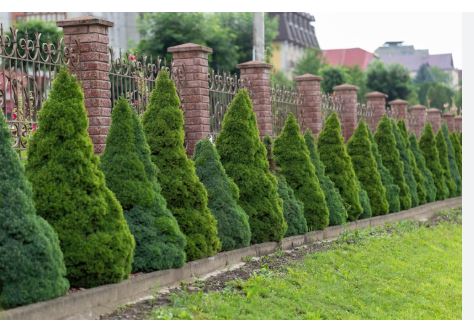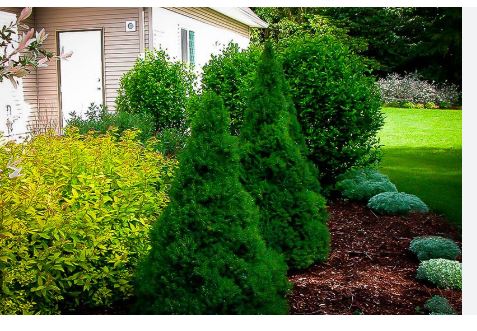
Dwarf Alberta Spruce, known scientifically as Picea glauca ‘Conica’, is a cultivar of the white spruce within the Pinaceae family, a group that includes pines, firs, and other conifers. The genus Picea encompasses about 35 species of evergreen trees, primarily native to northern temperate and boreal regions. The species Picea glauca, or white spruce, is a widespread North American conifer, and ‘Conica’ is a dwarf mutation prized for its compact, conical form. Unlike its towering parent, which can reach 100 feet, this cultivar stays small, typically topping out at 10–12 feet over decades. Its classification reflects its place among gymnosperms—seed-producing plants with naked seeds—under the order Pinales, aligning it with other needle-leaved evergreens.
The Dwarf Alberta Spruce originated as a natural mutation discovered in the early 1900s near Lake Laggan in Alberta, Canada. In 1904, botanists Arnold Arboretum’s Alfred Rehder and John G. Jack spotted this slow-growing oddity among wild white spruce and recognized its horticultural potential. Propagated via cuttings (since it rarely produces viable cones), it was introduced to the nursery trade by the 1920s, quickly gaining favor for its tidy shape and evergreen appeal. Named for its Alberta origins and dense, spruce-like needles, it became a staple in formal gardens and holiday decor, though its susceptibility to pests like spider mites later tempered its dominance in some regions.
While Picea glauca is native to northern North America—stretching from Alaska across Canada to the northeastern U.S.—the ‘Conica’ cultivar is a garden creation, not found in the wild. Its parent species thrives in boreal forests, often along riverbanks or in mixed coniferous stands, enduring harsh winters and short growing seasons. Since its discovery, Dwarf Alberta Spruce has been distributed globally through horticulture, popping up in landscapes from North America to Europe and temperate parts of Asia. It’s cultivated rather than naturalized, relying on human care to spread beyond its Alberta birthplace.
Spotting a Dwarf Alberta Spruce is easy with its distinct traits. It forms a dense, symmetrical cone, growing slowly at 2–4 inches per year, with soft, short needles (about half an inch long) in a bright green hue that darkens with age. Unlike the wild white spruce, its branches are tightly packed, giving a plush, almost fuzzy look—no pruning needed to maintain the shape. The needles radiate around twigs in a spiral, and while it rarely fruits, tiny brown cones may occasionally appear on older plants. In winter, it holds its color well, though stressed specimens might bronze slightly. Its petite stature and uniform growth set it apart from lankier conifers.
Dwarf Alberta Spruce thrives in USDA Zones 2 to 7, tolerating frigid lows down to -50°F (-46°C) and moderate summers. It’s happiest in cooler climates, mirroring its boreal roots, and can struggle in the heat and humidity of Zone 8 or higher, where poor air circulation invites pests. Well-drained, slightly acidic soil (pH 5.5–6.5) keeps it healthy, and it needs protection from scorching sun or drying winds in warmer zones to avoid needle burn.
In landscaping, Dwarf Alberta Spruce is a versatile star, perfect for small gardens or structured designs. Its naturally conical form makes it a go-to for foundation plantings, rock gardens, or as a living holiday tree in containers—often adorned with lights come December. Planted in pairs, it flanks doorways or paths with formal flair, while solo specimens add vertical accents to mixed borders. It’s low-maintenance (no shaping required), but its shallow roots and pest vulnerability mean it’s best sited away from hot, windy spots. For tiny yards or patios, it’s a compact evergreen gem—just don’t expect it to screen much, as it stays petite and dense.

Dwarf Alberta Spruce (Picea glauca ‘Conica’): Cultivation
Climate Compatibility
This cultivar excels in USDA Zones 2 to 7, withstanding winter lows to -50°F (-46°C). It prefers cool climates and struggles in hot, humid conditions above Zone 7, where heat stress and pests can take a toll.
Sunlight Requirements
Plant in full sun for optimal growth and density, though it tolerates light shade. In warmer zones, morning sun with afternoon shade helps prevent needle scorch from intense rays.
Soil Preferences
It thrives in well-drained, slightly acidic soil (pH 5.5–6.5), like sandy loam or loamy mixes. Avoid heavy clay or soggy sites—poor drainage leads to root rot, a common killer.
Watering Needs
Keep soil evenly moist but not waterlogged during its first year to establish roots. Once mature, water weekly during dry spells, ensuring the top inch dries out between sessions to avoid over-saturation.
Planting Time
Early spring or fall is best for planting, allowing roots to settle before summer heat or deep freezes. Container-grown specimens can go in anytime frost isn’t a threat, but avoid mid-summer stress.
Spacing
Space plants 3 to 6 feet apart, depending on use—closer for a tight hedge, wider for standalone features. Its slow growth (2–4 inches yearly) means it won’t crowd quickly, topping out at 10–12 feet.
Fertilization
Apply a slow-release, acid-loving fertilizer (like 10-8-6) in early spring before new growth emerges. Don’t overdo it—too much nitrogen causes leggy growth and weakens its dense form.
Mulching
Spread a 2- to 3-inch layer of organic mulch (pine bark or wood chips) around the base to retain moisture and keep roots cool. Pull mulch back from the trunk to prevent rot and pest hideouts.
Pruning Practices
Pruning is rarely needed thanks to its natural cone shape, but trim dead or damaged tips in late winter with clean shears. Avoid heavy cuts—new growth won’t sprout from old wood.
Pest Management
Watch for spider mites, especially in hot, dry weather—yellowing or stippled needles signal trouble. Blast them off with water or use horticultural oil; aphids and bagworms may also pop up, treatable with insecticidal soap.
Disease Prevention
Good air circulation curbs fungal issues like needle cast or rust, which brown needles. Avoid overhead watering, and remove fallen debris to limit spore spread—wet, shady spots worsen these risks.
Winter Protection
In windy areas or Zones 2–3, shield young plants with burlap to prevent desiccation from cold, dry gusts. Mature shrubs handle snow well, but brush off heavy loads to avoid branch breakage.
Propagation
Propagate via softwood cuttings in early summer—dip 4-inch tips in rooting hormone and plant in a moist, sandy mix. It rarely produces cones, so seed isn’t an option; expect slow rooting over months.